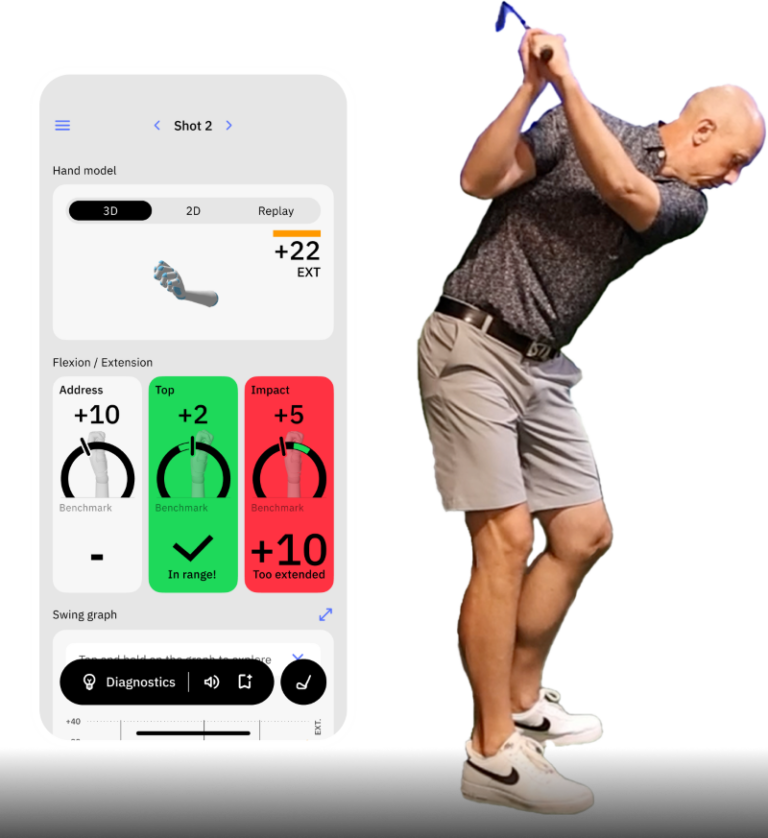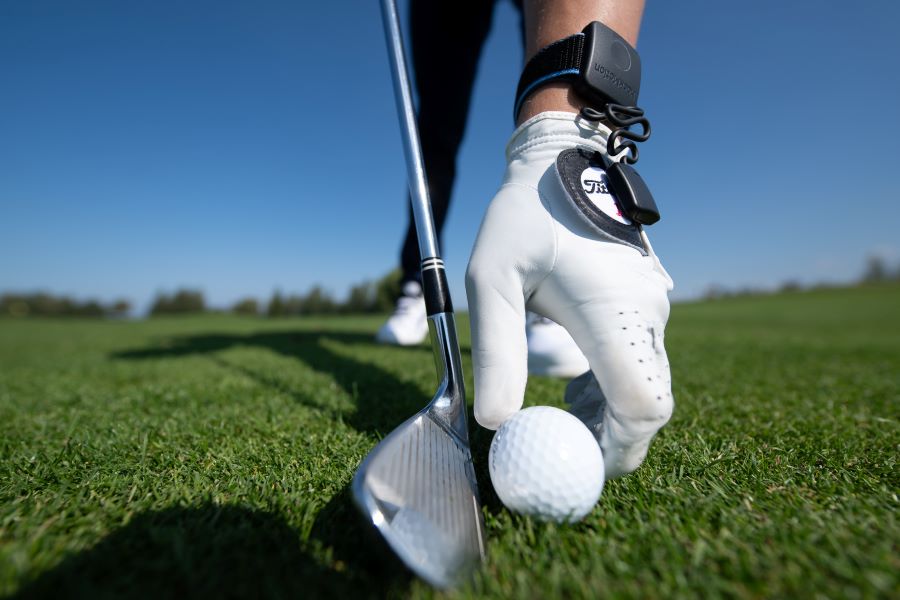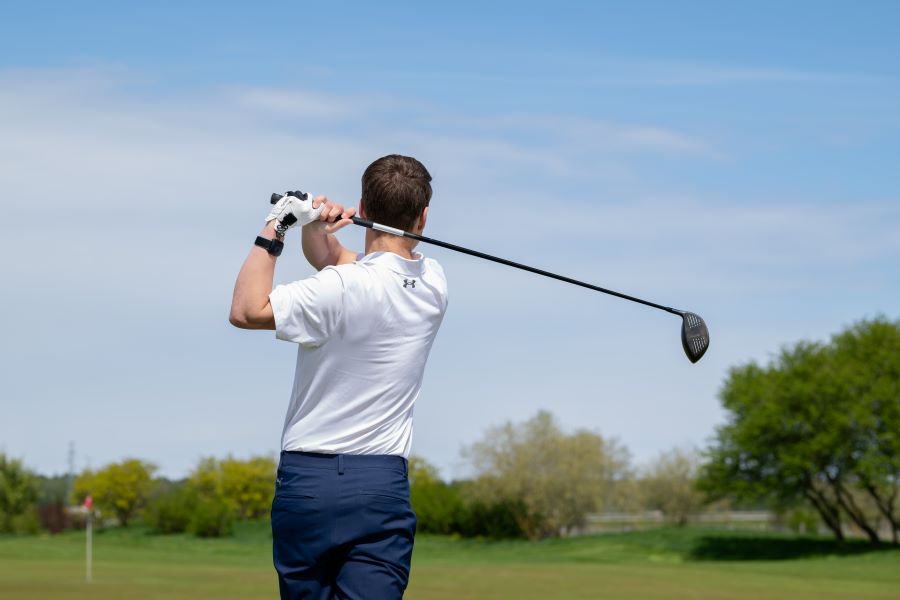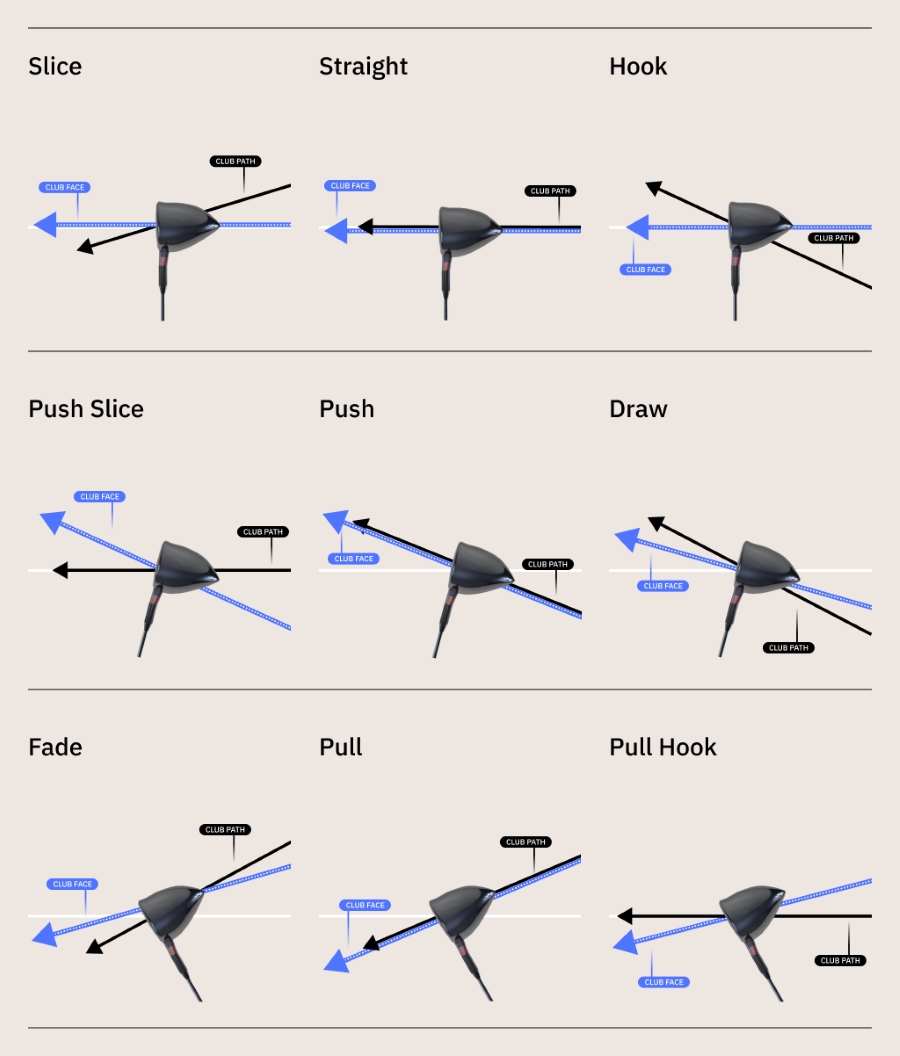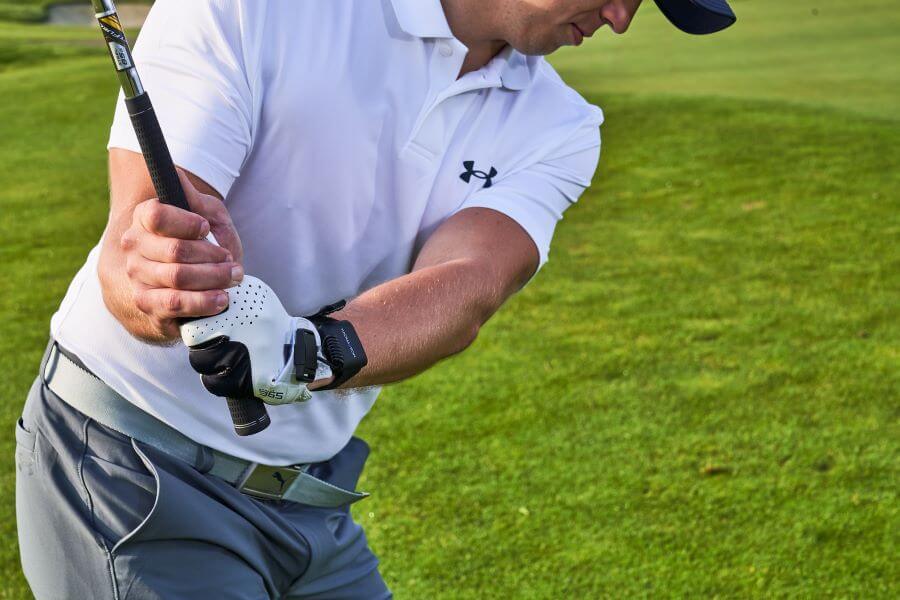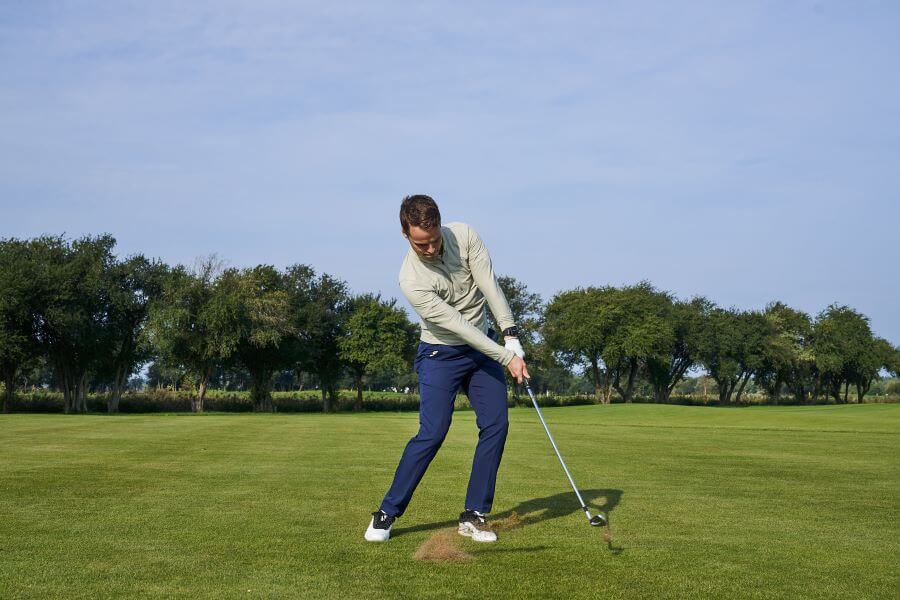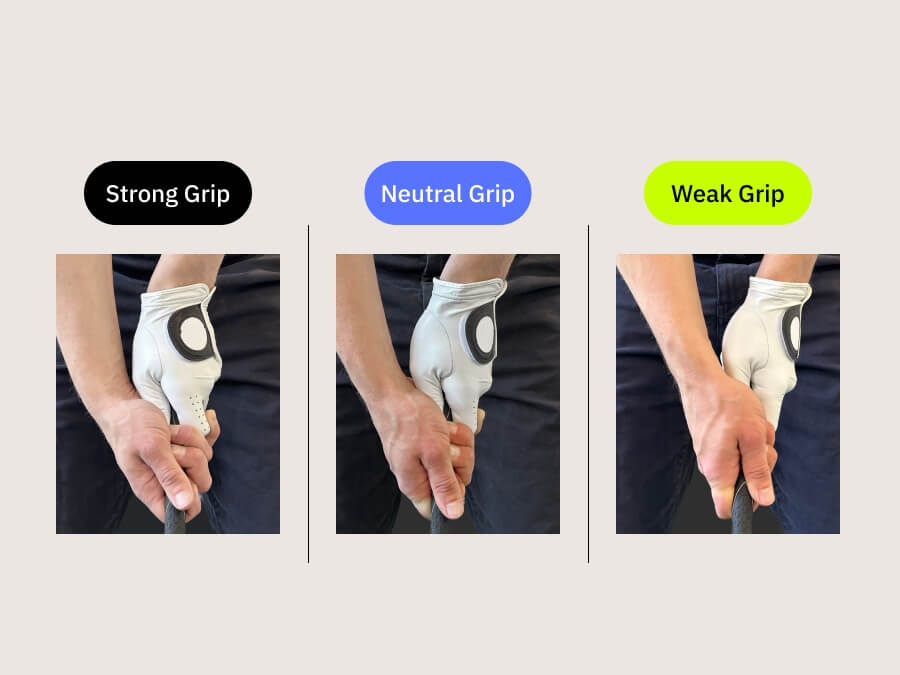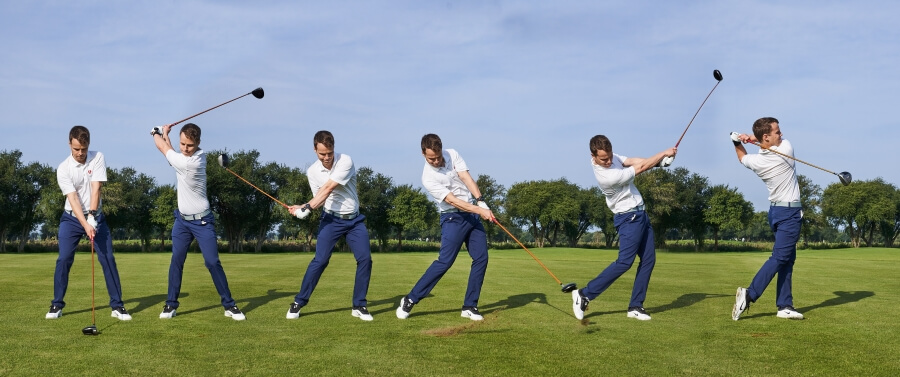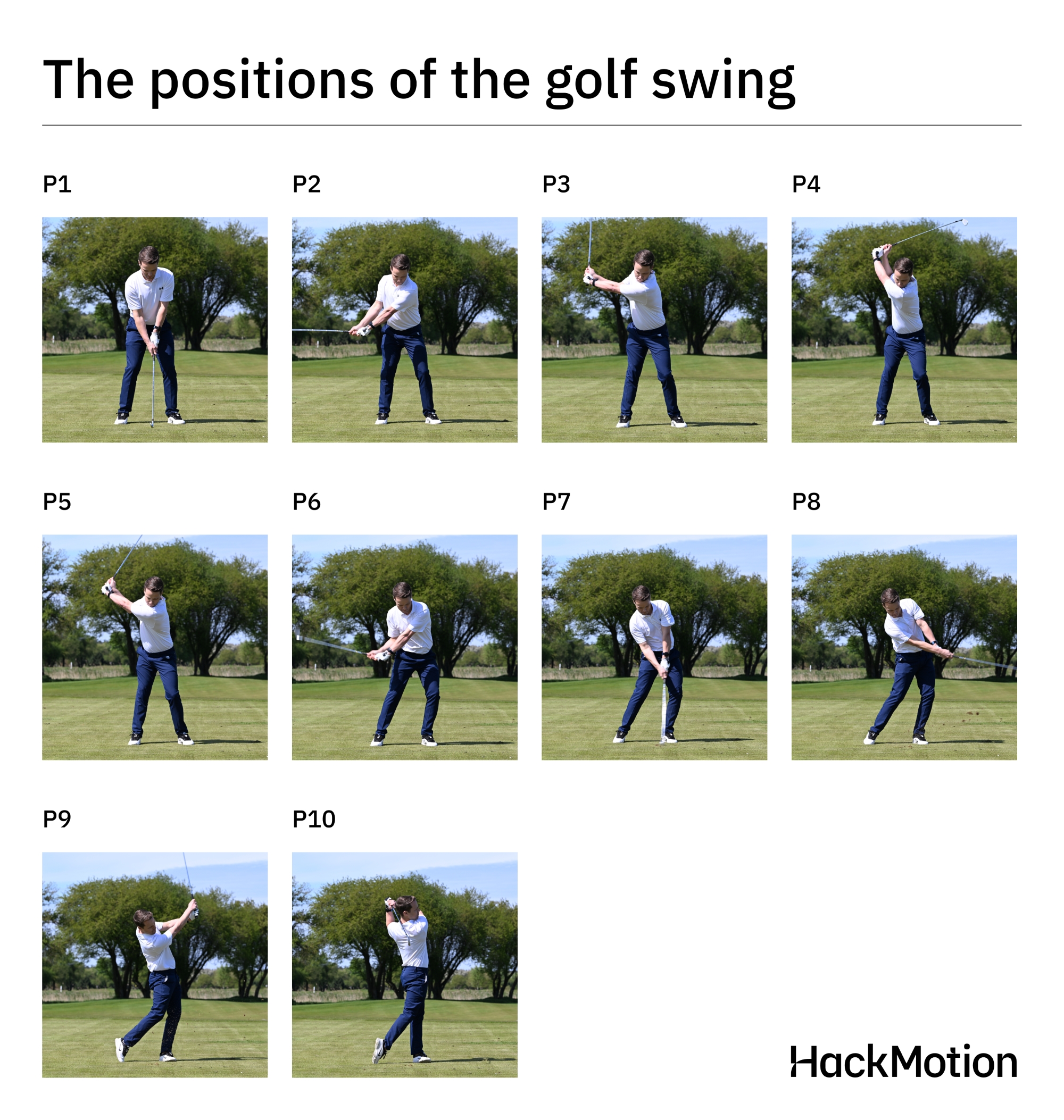How to Hit Your Golf Ball Higher for Maximum Carry Distance on Soft Turf
Learning how to hit your golf ball higher enables you to clear towering trees, ride the tailwind and promote a soft landing.
In this post, I reveal the step-by-step process to hit your driver and irons higher to boost your carry distance off the tee and on approach.
After reading our review on the best way to hit higher golf shots, you’ll learn the importance of weaker lofted clubs and a low shaft kick point. In addition, I explain why a forward ball position, wrist flex, and neutral grip pressure provide the control and power needed for a high launch.
How to Hit a Golf Ball Higher – Too Long, Didn’t Read
- Play higher lofted clubs to leverage the launch assistance.
- Swing a low kick point shaft to generate a higher launch.
- Place the ball further forward than usual to shallow the golf shaft on the downswing.
- Neutral grip pressure helps you unload from the top for maximum acceleration.
- Use wrist flexion to shallow the shaft into impact.
- Neutral grip pressure helps you to unload from the top and generate optimal pace.
- Accelerate through impact to finish with high hands and elevated ball flight.
Contents
How to Hit a Golf Ball Higher with a Driver?
1. Higher Loft
The first tip to hitting higher tee shots with a driver is to operate with a weaker lofted driver. Big sticks with a higher loft sport an open clubface, which provides an air of launch assistance for golfers with slower swing speeds.
Most drivers for amateurs range from 9 to 12 degrees, with the latter better suited to slow swing speeds, seeking towering flight. In addition, a 10.5-degree driver is a popular option for moderate-swing-speed golfers.
A 12-degree driver will typically launch higher than the 9-degree setup, which offers one solution to achieving an enhanced apex.
2. Low Kick Point Shaft
Sticking with equipment tips, I recommend a flexible shaft with a low kick point. These golf shafts are built to deliver superior flex into impact, which improves energy transfer for a clean strike, low spin, rapid pace, and a lofty launch.
The higher the kick point on a shaft, the lower you’re likely to launch your golf ball.
Low kick points can feature on stiff, moderate, and super flexible shafts. However, I find they are more commonly associated with the latter.
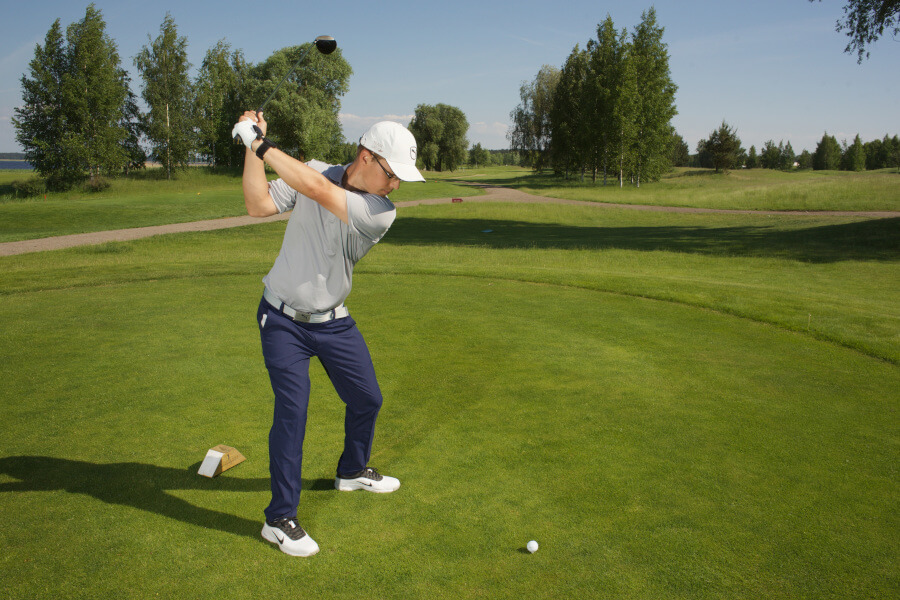
3. Tee the Ball Higher
After acquiring the correct equipment specs for your swing, ensure your ball is teed up sufficiently to promote clean clubface contact. You want to strike the ball slightly above the center of the clubface to reduce spin and promote an elevated launch angle.
However, when your golf ball is teed too low, you risk catching the ground before impact as you attempt to catch the ball higher on the clubface. Striking the turf prior to contact costs you clubhead speed and energy transfer resulting in a weak launching tee shot.
The optimal tee position depends on your attack angle. Your ball is best teed higher up than the crown of your driver if you produce a shallow angle of attack. Conversely, I tee my ball down more than my peers to account for my steeper attack angle.
When I tee the ball up too high, the steep shaft into impact causes me to catch the bottom of the ball with the top of my crown. This causes the ball to pop up and fall back to earth, as Meandmygolf explains in this video.
4. Wider Stance
Golf coach Chris Ryan (video below) explains that a wider stance is imperative for helping you get behind the ball.
In addition, by widening your golf stance, you position the ball to the left or further forward. This minor change helps to extend the gap between where the ball is and the buttons on my shirt.
Ryan continues suggesting that the wider this gap becomes, the easier it is to hit up on the golf ball. A wider stance delivers superb stability during your swing and lowers your center of gravity for superior hip rotation and shoulder turn through impact.
Finally, a wide stance sets you up behind the golf ball, prompting you to catch it on your upswing and propel it into the sky.
5. Ball Aligned with Your Front Heel
Next, you need to alter the position of your golf ball, ensuring it sits further forward in your stance, aligning with your lead heel.
A forward ball position encourages you to catch the ball after the low point of your swing, sending the ball high and long.
In addition, the forward ball set up accounts for the added length of your driver shaft. By moving the ball up in your stance, you leave yourself sufficient time to generate optimal swing speed and square your clubface to hit a straighter golf shot.
When you combine speed, power, and low spin with striking the ball on the up, you enjoy a mountainous launch and sublime carry yardage.
6. Tilt Your Shoulder at Address
The penultimate part of your setup to hit a golf ball higher with a driver is tilting your lead shoulder at address. Admittedly I don’t follow this rule, but I’ve seen it work several times for my peers. Tilt your shoulders slightly back at address, keeping them parallel to the target line.
Leaning your shoulders gives you the sensation you want to achieve at contact as you accelerate on your upswing. At impact, your lead shoulder should rest higher than the trail shoulder while remaining aligned with the target.
Ultimately tilting your shoulders at address is designed to encourage an upwards strike after the low point of the swing.
7. Neutral Grip
The final factor before commencing your swing is to create a neutral grip with subtle pressure. When you grip the club firmly, it restricts your ability to control your clubface and unload optimally on the downswing for added power.
Brandon Steele suggests that tightening your grip pressure generates tension in your shoulders and arms, resulting in an unbalanced swing. The three-time PGA Tour winner continues to explain that the muscle tension causes players to overswing and swing excessively hard.
In addition, Steele states that tight grip pressure prevents you from effectively releasing the clubface into contact. As a result, amateurs often leave the clubface open and don’t catch the sweet spot, leading to a sliced golf shot.
I suggest employing tight and weak pressure to identify the optimal grip tension. Start by gripping your club tightly to the point where it feels like you’re strangling your grip. Notice how it reduces your freedom of motion and control of the club.
Next, release tension to the point where the club practically falls out of your hands. The light pressure makes it challenging to control your club from takeaway to impact.
Finally, with the memory of tight and light pressure fresh in thought, adjust your pressure midway between the two.
Learn More: Strong vs Weak Grip in Golf.
8. Flex Wrists on the Downswing
After religiously employing the HackMotion sensor in my training routine, I’ve learned that wrist flexion on the downswing is essential. Flexing or cupping your wrists on the downswing helps shallow your shaft and marginally close the clubface to avoid slicing or pushing your shot.
For context, if you hold your hand out in front of you with the palm facing the floor and push your fingers down, you’ve flexed your wrist. From this position, turn your hand around so your palm faces the target. Notice how your palm is closed to the target, which along with shallowing the shaft, is what wrist flexion achieves.
Shallowing the shaft on the downswing increases the distance the clubface needs to travel to reach the golf ball.
The further it travels to the golf ball, the more time you have to gather momentum and accelerate into impact. A shallow club into contact helps you sweep the ball off the tee and into the air.
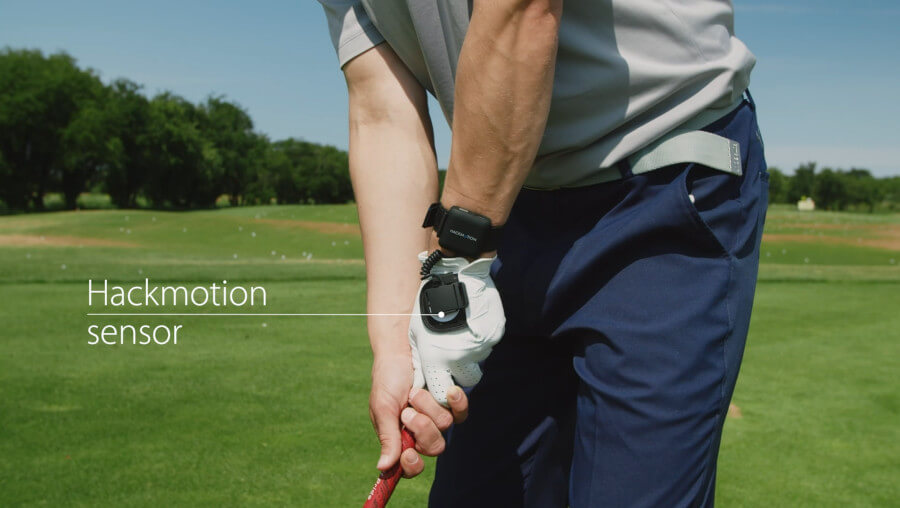
9. Strike the Ball After the Swing Low Point
Since your ball is teed-up for a drive, you have to strike it on the up to help it off the peg and into the sky. If you hit the ball with a descending blow, the chances are that you will generate inadequate speed and energy transfer at impact, resulting in a shallow and weak launch.
Now, the best ball strikers on the planet can launch the ball high and long when hitting down on it. However, most of us cannot generate Bryson DeChambeau club head speed and instead need lift assistance for consistent launch, flight and carry distance.
Chris Ryan provides an easy but effective drill to work on striking the ball as you commence your upswing. Place a tee 3 to 5 inches behind your golf ball, and your head cover 5 inches ahead of the impact zone.
The tee acts as my marker for the low point of the swing. Anything before that will cause my driver to plough into the turf and lose clubhead speed. Conversely, if I strike the ball like an iron shot before my club bottoms out, I’ll hit the head cover ahead of my ball.
It became a breeze to picture the setup when I was playing after practicing this drill for a few months. It’s seriously boosted the consistency of my control into impact and the cleanliness of my strikes.
10. Accelerate Through Impact
The final step for hitting a driver higher is accelerating through impact to generate sufficient momentum to get your hands high on the upswing. Contrary to the breaking mechanism of low hands in my how-to-hit a low-shot review, a steep launch demands high hands.
Your hip rotation and shoulder turn generate your power, lag, and speed on the downswing. Initiate the transition from the top of your swing down by shifting your weight from your back leg forward to generate lag.
Turn your shoulders on the downswing and keep them turning until your chest is facing parallel to the target.
Generating precise hip rotation and shoulder turn gives you the speed, power, and energy transfer needed to launch the ball high and long off the tee.
How to Hit a Golf Ball Higher with Irons?
Most prompts to hit a golf ball higher with irons are the same as for a driver, albeit with a few tweaks.
High iron shots are hit by employing forward shaft lean at address, progressive ball position, level shoulders, and delivering a descending blow to the golf ball.
However, you still require weaker lofts and flexible, low-kick point shafts. Moreover, a neutral grip and wrist flexion on the downswing is vital for improved clubface control and power leading into impact.
1. Forward Shaft Lean
Contrary to the logic most golfers employ, setting up with forward shaft lean is the first step I take to hit a high iron shot. Ultimately, I need maximum compression at impact to create rebound and ball velocity. This tweak will ascend the ball into the air for greater carry distance on approach.
After addressing the ball, I put my hands ahead of the golf ball, creating a forward shaft tilt. This position closes and delofts my clubface, which you may think is counterintuitive, but it’s what is required.
Producing superior levels of compression with iron shots takes the spin off the golf ball and imparts rampant speed.
It’s a welcome combination for a towering ball flight as the aerodynamic, fast ball cuts through the air and ascends before reaching its apex.
2. Progressive Ball Position
When I plan to hit a high golf shot, I set up with the ball marginally forward of where I’d usually place it. This position change increases the distance my clubhead has to travel from the top down to impact, conjuring ample power and speed throughout the swing.
The added speed boosts energy transfer into impact leading to sublime rebound and velocity for an elevated launch. Despite the advantages of placing the ball more forward than usual, I still follow the progressive setup, depending on the iron in hand.
For example, I place the ball 3 to 4 inches back from my lead heel for a 4-iron shot but put it forward of center for a mid-iron strike.
Finally, I set my golf ball up in a back-of-center position when swinging a short iron or wedge.
3. Descending Blow
The final step to hitting the golf ball higher with irons is to strike the ball with a descending blow prior to the low point of your swing.
When your clubface strikes the golf ball at this point, you generate exceptional compression, prompting rapid rebound, ball speed, and low spin.
You should hit the ball first and then the ground, proceeding to take a juicy divot. If you strike the ball at or after the low point of your swing, you generate weak contact and lose clubhead speed. Clubhead speed loss prevents you from delivering optimal compression, resulting in a low launch and reduced carry distance.
I find that flexing my wrists on the downswing and shallowing my shaft augments my control and ability to guide the clubface to the ball before it bottoms out.
A drill I often use to promote a descending blow is to take quarter swings. I hit 20 to 30 balls, only focusing on hitting the ball first, then the turf, and optimizing compression.
Summary
My detailed guide on how to hit your golf ball higher gives you a road map to employ on your driver and iron shots.
Remember to use weaker lofted clubs, flexible shafts with a low kick point, and a neutral grip. Plus, always accelerate through impact to boost power, lag, and promote finishing with high hands.
Finally, although multiple steps are involved in hitting higher golf shots, wrist flexion is vital for shallowing the shaft and closing the clubface on the downswing.
Operating with the incorrect level of wrist flexion on the downswing impacts your clubface angle and your ball flight.
The HackMotion golf wrist sensor trains you to induce the ideal flexion and extension during your swing for improved clubface control, power, and accuracy. Learn how it can unlock your ability to hit towering iron and tee shots.
